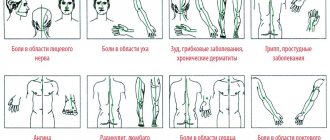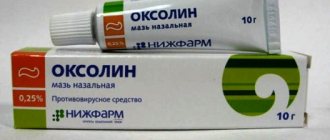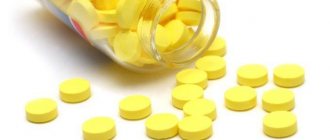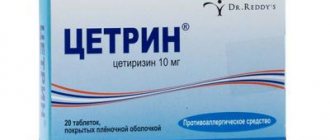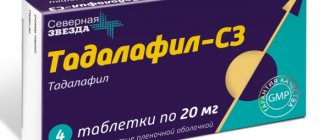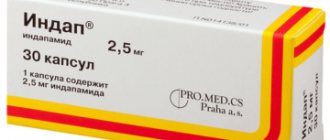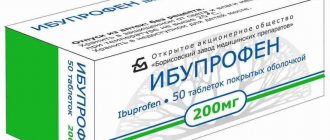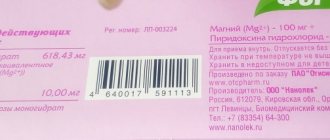Pharmacodynamics and pharmacokinetics
Pharmacodynamics
Antibacterial agent with bacteriostatic action. Refers to fusidins , antimicrobial substances whose action is based on disruption of protein biosynthesis in the bacterial cell.
The most sensitive to the drug Fucidin are gram-positive microorganisms and gram-negative cocci: Streptococcus pyogenes, Neisseria meningitidis and gonorrhoeae, Staphylococcus aureus and epidemridis, Corynebacterium minutissimum, Nocardia asteroides, as well as representatives of the genera Pseudomonas and Clostridium.
The drug is not active against E. coli , as well as representatives of the genera Salmonella and Proteus, protozoa and fungi.
Pharmacokinetics
When used externally, absorption into the systemic circulation is low.
FUCIDIN: SIDE EFFECTS
Side effects are very rare and can be expected in approximately 5% of patients.
Determination of the frequency of adverse reactions: very often (> 1/10), often (> 1/100 and 1/1000 and 1/10,000 and
Dermatological reactions: uncommon - rash (erythematous, maculopapular, pustular), skin irritation, including pain, burning sensation, tingling sensation on the skin, itching, dry skin, contact dermatitis; rarely - eczema, periorbital edema, erythema.
Allergic reactions: rarely - urticaria, angioedema, eczema.
From the organ of vision: rarely - irritation of the conjunctiva.
The patient should inform the doctor about the occurrence of any side effects listed or not listed above.
Instructions for use of Fucidin (Method and dosage)
Cream and ointment are applied and used externally only.
Fucidin cream, instructions for use
Patients of all ages are prescribed to apply Fucidin cream to the affected areas of the skin up to 4 times a day. When using gauze bandages, the frequency of application is reduced to 2 times a day.
The duration of cream treatment depends on the clinic and the form of the disease and averages 1-2 weeks.
Fucidin ointment, instructions for use
Patients of all ages are prescribed to apply Fucidin ointment to the affected areas of the skin up to 4 times a day. When using gauze bandages, the frequency of application is reduced to 2 times a day.
The duration of treatment with ointment depends on the clinic and form of the disease and averages 1-2 weeks.
FUCIDIN
Drug: FUTSIDIN® Active substance: fusidic acid ATC code: D06AX01 KFG: Antibiotic for external use Reg. number: P No. 011114/03 Registration date: 08/19/05 Owner of reg. credential: LEO PHARMACEUTICAL PRODUCTS {Denmark}
DOSAGE FORM, COMPOSITION AND PACKAGING
Cream for external use 2% homogeneous, white.
| Cream for external use | 1 g |
| fusidic acid anhydrous | 20 mg |
Excipients: butylated hydroxyanisole, cetyl alcohol, glycerol 85%, liquid paraffin, potassium sorbate, polysorbate 60, white soft paraffin, purified water.
15 g - aluminum tubes (1) - cardboard packs.
Ointment for external use 2% homogeneous, translucent, from white to yellowish-white.
| Ointment for external use | 1 g |
| sodium fusidate | 20 mg |
Excipients: lanolin, cetyl alcohol, liquid paraffin, white soft paraffin.
15 g - aluminum tubes (1) - cardboard packs.
The description of the drug is based on the officially approved instructions for use.
PHARMACHOLOGIC EFFECT
Belongs to the group of fusidines, antimicrobial compounds, the mechanism of action of which is associated with disruption of protein synthesis in the bacterial cell. By blocking the elongation of factor G, they prevent it from binding to ribosomes and guanosine triphosphate, which interrupts the release of energy necessary for protein synthesis and leads to the death of the bacterial cell.
Gram-positive bacteria (Staphylococcus aureus, Streptococcus pyogenes, Corynebacterium minutissimum), gram-negative bacteria (Pseudomonas spp.) are sensitive to sodium fusidate.
There are no reports of cross-resistance to sodium fusidate.
PHARMACOKINETICS
The permeability of fusidic acid through intact skin is low and amounts to 0.54% of the applied amount of the drug.
INDICATIONS
- bacterial skin infections in adults, adolescents, children and newborns.
DOSING REGIME
Cream and ointment are applied to the affected areas of the skin 3 times a day for 10 days.
SIDE EFFECT
Dermatological reactions (listed in descending order of frequency of occurrence): itching, irritation, burning and tingling sensation, dry skin, rash (erythematous, maculopapular, pustular), contact dermatitis, eczema, erythema, periorbital edema.
Allergic reactions: urticaria, angioedema.
The incidence of side effects is very rare and amounts to 2:1,000,000 treatment courses.
CONTRAINDICATIONS
- hypersensitivity to the components of the drug.
PREGNANCY AND LACTATION
The drug should be prescribed with caution during pregnancy and lactation (breastfeeding).
Experimental studies have established that fusidic acid does not have embryotoxic or teratogenic effects.
SPECIAL INSTRUCTIONS
When using Fucidin ointment on the face, you should be careful, because In case of contact with the eyes, sodium fusidate causes irritation of the conjunctiva.
OVERDOSE
Data on overdose of the drug Fucidin are not provided.
DRUG INTERACTIONS
Drug interactions with Fucidin have not been described.
CONDITIONS OF VACATION FROM PHARMACIES
The drug is available with a prescription.
CONDITIONS AND DURATION OF STORAGE
List B. The drug should be stored out of the reach of children at a temperature not exceeding 25°C. Shelf life: 3 years.
special instructions
The drug should not be applied to the skin of the eyelids, as fusidic acid causes irritation of the conjunctival .
The cream contains butylated hydroxyanisole, potassium sorbate and cetyl alcohol , and the ointment contains cetyl alcohol and lanolin . These substances cause the development of local allergic skin phenomena .
Butylated hydroxyanisole may also cause irritation to mucous membranes and eyes.
When using fusidic acid, the development of bacterial resistance cannot be ruled out. Prolonged or regularly repeated use may increase the risk of antibacterial .
There was no effect of the drug on the ability to drive a car.
Release form, composition and packaging
Cream for external use 2% homogeneous, white to almost white.
| 1 g | |
| fusidic acid hemihydrate | 20.4 mg, |
| which corresponds to the content of anhydrous fusidic acid | 20 mg |
Excipients: cetyl alcohol - 111 mg, glycerol 85% - 111 mg, liquid paraffin - 111 mg, white soft paraffin - 56 mg, polysorbate 60 - 56 mg, hydrochloric acid - qs to pH 5, potassium sorbate - 2.7 mg, butylated hydroxyanisole - 40 mcg, water - approx. 531 mg.
15 g - aluminum tubes (1) - cardboard packs.
Ointment for external use 2% homogeneous, translucent, yellowish to white.
| 1 g | |
| sodium fusidate | 20 mg |
Excipients: lanolin - 46 mg, cetyl alcohol - 4 mg, liquid paraffin - 140 mg, white soft paraffin - 790 mg.
15 g - aluminum tubes (1) - cardboard packs.
pharmachologic effect
Fucidin ointment (instructions for use contain the following information) penetrates human skin by only 2% of the mass of the product used for application to the affected area. Due to this, a minimal level of absorption is observed. Most of the main component of the ointment is excreted along with bile. The rest of the drug leaves the body through urination.
Local antibacterial, anti-inflammatory and glucocorticoid effects.
Cream for effective treatment of acne Fucidin
The drug Fucidin for acne on the face is an effective antibacterial drug that is used in the treatment of many dermatological problems. The medicine is intended for external use and makes it possible to cleanse the skin in 1.5-2 weeks, depending on the severity and nature of the skin rash.
Composition and release form
To combat pimples, external dosage forms of the drug are used. The product in the form of an ointment has a translucent structure and does not have a specific odor. It is placed in tubes of 15 g. The active ingredient of the medicine is sodium fusidate. In 1 g of the drug its concentration is 20 mg.
Additional Ingredients:
- lanolin;
- liquid and soft paraffin;
- cetyl alcohol.
A homogeneous cream-gel for acne is placed in the same tubes as the ointment. It is white in color and has virtually no odor. The active component of the acne remedy is anhydrous fusidic acid (2 mg per 1 g of medicine). Auxiliary elements:
- liquid paraffin;
- glycerol at a concentration of 85%;
- cetyl alcohol;
- white paraffin;
- hydrochloric acid;
- filtered water;
- potassium sorbate;
- butylated hydroxyanisole.
Also on sale is the drug Fucidin G for subcutaneous acne. It is made in the form of a cream and has a white color. It contains 2 active components at once - hydrocortisone acetate and fusidic acid. Secondary composition elements are identical to homogeneous cream 2%.
Mechanism of action
The medicinal activity of the acne medication is explained by the presence of fusidic acid in its composition. This natural antibiotic is absorbed by the skin and then enters the body. Metabolism of the substance occurs in the structures of the liver. It is excreted along with urine and bile.
Fusidic acid disrupts the production of protein by the cell walls of pathogenic bacteria. As a result, they stop reproducing and gradually die. The active substance is active against gram-negative and gram-positive microorganisms.
The use of ointment or cream in the treatment of acne caused by E. coli, Proteus, fungi and salmonella does not give a positive result, since fusidic acid does not have an antibacterial effect on these pathogens. In addition, the medication has an anti-inflammatory effect, eliminating itching and burning of the skin.
Indications for use
The drug is used for many dermatological problems. Main indications:
Folliculitis
- folliculitis;
- carbuncles;
- boils;
- impedigo;
- acne;
- hidradenitis;
- sycosis and other dermatological infections caused by bacteria sensitive to the action of fusidic acid.
Contraindications
The instructions for using the medicine say that it should not be used to treat children under 2 years of age. Other contraindications:
- herpes;
- mycosis;
- individual intolerance to the ingredients of the medication;
- chicken pox;
- cutaneous tuberculosis;
- perioral dermatitis;
- acne rosacea;
- manifestations of syphilis on the skin.
The advantage of this cream and ointment is that it can be used during pregnancy, since the medication does not have a negative effect on the fetus, which is confirmed by numerous clinical trials. In this case, experts advise giving preference to 2% ointment or cream. You should avoid taking Fucidin G because it contains hydrocortisone.
During lactation, Fucidin can be used, since its active substances do not enter the composition of mother's milk. However, it is not advisable to treat pimples near the nipples with this remedy.
Reception scheme
Regardless of the dosage form, a number of rules must be followed when taking this drug. The main ones:
- Do not apply other products to the ointment or cream. In addition, it is not advisable to use Fucidin as a makeup base. Therefore, it is recommended to apply it to the surface of the skin before bed.
- Before the treatment procedure, the epidermis must be thoroughly cleaned using makeup removers. Additionally, it is advisable to wash your face with clean water and soap. After this, wipe your face dry with a soft and clean towel.
- To treat, you need to squeeze out a little cream or ointment, then evenly apply the composition to the problem area and rub it in with gentle massaging movements until completely absorbed. During the procedure, you should avoid getting the medication into the areas around the eye sockets, otherwise the risk of glaucoma increases. In addition, it is forbidden to apply medicinal ointment to open wounds.
- You can make lotions based on the ointment. To do this, you need to squeeze a little medicine onto a cotton sponge, then apply it to the problem area and secure it with a band-aid. The lotion should be worn for 2-3 hours.
The frequency of use of the medication depends on its dosage form. Standard ointment is applied 3-4 times a day. Lotions based on it should be made no more than 1-2 times a day. The composition of Fucidin G is best used before bedtime, and the 2% cream can be applied to the epidermis every evening. The average duration of therapy is from 10 to 14 days.
Experts and patients note that the first positive results with the use of Fucidin can be seen within 3-4 days after the start of treatment . If acne spots remain after the course, you should additionally use the drug for several days.
Side effects
In most cases, patients tolerate treatment with this medication. The following negative reactions are rarely observed:
- dermatological disorders in the form of minor burning and tingling;
- manifestations of an allergic nature in the form of rash, redness and itching;
- lightening of areas of the skin that have been treated with medication;
- development of the inflammatory process in the affected area;
- hair growth on the facial skin (hypertrichosis);
- atrophy of the skin.
If any negative manifestations occur, you should stop using the ointment or cream, and then immediately contact a medical specialist.
It is forbidden to use Fucidin for too long and often, as this can lead to disruption of skin pigmentation and the occurrence of acne.
Cost of the drug
The cost of ointment is from 450 to 520 rubles, homogeneous cream 2% is from 475 to 585 rubles, Fucidin G is 410-490 rubles. The price of the medicine may vary depending on the region and pharmacy.
Analogs
Analogues of Fucidin:
- Hyoxyzone . In pharmacies this medication is sold at prices ranging from 50 to 120 rubles. It is produced in the form of an ointment. The medicine has pronounced anti-inflammatory activity and allows you to quickly relieve discomfort in a number of dermatological pathologies caused by bacterial infections and allergic reactions. This ointment has approximately the same pharmacotherapeutic effect as the drug Fucidin, but it has a thicker consistency.
- Oxycort . A combination medicine that contains oxytetracycline and hydrocortisone. It is produced in the form of ointments, gels or suspensions for oral administration. The drug demonstrates high effectiveness in the treatment of many dermatological diseases caused by bacterial infections.
- Fusidine sodium. The drug is manufactured in the format of tablets that are enteric-coated. The instructions say that it is used in the treatment of otitis media, pneumonia, furunculosis, infectious lesions of soft tissues, festering burns and wounds. It is prohibited to give the drug to children under 3 years of age and to patients with individual intolerance to the substance and its composition.
- Fusiderm . The product is produced in the form of a gel, ointment or cream for external use. It is available with a doctor's prescription, as it has a wide list of contraindications and side effects.
The attending physician should be in charge of selecting an analogue.
Reviews
Tatyana, 33 years old, Syktyvkar. Despite the fact that this drug is intended for external use, it is a powerful antibiotic.
About 4 months ago I suffered from a severe flu, after which a small spot appeared on my left arm, which, under the influence of sunlight, increased in size and became darker. To avoid trouble, I decided to see a dermatologist.
The doctor found that this is not a birthmark, but a type of lichen that many residents of large cities face.
For treatment, the doctor prescribed the drug Fucidin. I smeared it on the problem area until the pigmentation completely disappeared. The dark spot began to gradually lighten and become less visible after applying the ointment. After 1.5 weeks there was no trace left of him.
The medicine is effective, inexpensive and sold in almost any pharmacy. If the doctor had prescribed another drug for me, the therapy might have been delayed for a long time.
Now I bought another tube of medication to use if necessary.
Anatoly, 39 years old, Volgodonsk. I work on a woodworking machine. Recently I severely burned my hand when I was changing a casing element on a machine engine. It turned out that as a result of this idea he received a severe burn on his palm. On the same day I went to the hospital.
The doctor recommended a course of treatment with Fucidin cream. Only 2 weeks of sick leave was enough for the patient to restore damaged skin. A small scar remained at the site of the burn.
In the first days of using the ointment, slight swelling appeared in the treated area, which disappeared on its own in the subsequent days of therapy.
Alla, 43 years old, Samara. This ointment is always in our home medicine cabinet. It copes well with suppuration and inflammatory processes in the epidermis.
The medication works effectively and in the shortest possible time. About a year ago, with its help, I was able to quickly cure lichen.
Now I use Fucidin to prevent the appearance of pimples on different parts of the body.
Recently I decided to try to eliminate the rashes on my husband’s back. The medication also coped with this task. There were no adverse reactions, neither for me nor for my husband.
Alexey, 46 years old, Tver. I recommend this medication to my patients to eliminate various skin problems caused by bacterial infections.
The ointment quickly eliminates boils, boils, acne and other types of dermatological formations. The pronounced effect of the medication begins after the initial treatment. At the same time, the active substances are not absorbed into the systemic circulation.
No cases of resistance were observed. The medicine is sold in almost any city pharmacy.
Source: https://gidbody.com/krasota-i-uhod/pryshhi-i-vysypanija/fucidin-ot-pryshhej
Interaction with other drugs
The remedy stands out among other antibacterial ointments for the following features:
- helps destroy pathogens that affect the skin;
- has an active effect against various bacteria;
- restores damaged skin areas;
- well tolerated by most patients.
Be careful! After using Fucidin, the patient may experience an allergic reaction. To prevent this problem, it is recommended to conduct a special sensitivity test to the components of the medication before using the product.
Read the site’s popular article: Effective ways to boost an adult’s immunity at home.
No significant interactions of the ointment with other drugs were identified. In some cases, doctors prescribe this drug along with drugs belonging to the category of penicillins and tetracyclines.
The possibility of using the ointment with other medications must be discussed with your doctor.
Contraindications
Contraindications to the use of Fucidin:
- hypersensitivity to the components of the drug;
- hyperprothrombinemia;
- pregnancy.
The following is prescribed with caution:
- with liver failure;
- diseases of the biliary tract.
Contraindications to the use of Fucidin G cream:
- fungal infection on the skin;
- herpes;
- chicken pox;
- lupus;
- cutaneous form of syphilis;
- perioral dermatitis;
- intolerance to the components of the drug;
- children under two years old.
Fucidin G is not used for fungal infections of the skin, herpes, chickenpox, skin tuberculosis, cutaneous syphilis, and perioral dermatitis.
When applying the cream, you need to make sure that the drug does not get on the mucous membrane or open wound.
Overdose
Treatment of acne with fucidin ointment, based on the instructions, is recommended as a course. The duration of the course is selected individually by a dermatologist
The medicine will speed up the patient's recovery process only if it is used correctly.
Note! The attending physician should tell you in detail about the rules for using Fucidin ointment. The instructions for use also contain this information.
The ointment is intended for external use only. Before applying it to the infected area, you must thoroughly wash and dry the skin.
If pus or other unnatural discharge has formed in the wounds, it is advisable to carefully remove them. You need to apply a small amount of the medicinal composition. It should be evenly distributed over the entire problem area by performing massage movements with your fingers.
For both children and adults who have been prescribed the drug, experts recommend applying it to the affected area of the skin at least 3-4 times a day. The ointment is often placed under a gauze bandage, which allows you to securely fix the medicinal composition in the right place. In this case, you should limit yourself to just 1-2 applications of the product.
An overdose of a medicinal product, which is available in the form of an ointment, is unlikely. Only in rare cases was a significant excess of the prescribed dosage of Fucidin diagnosed.
There were no dangerous reactions observed on the part of the body that could lead to a significant deterioration in the patient’s health.
Find out what doctors recommend when your fingernails peel. The main causes and treatment of peeling nails.
The cream is applied and used externally only.
Persons over 2 years of age are prescribed to apply a thin layer to the affected part of the skin up to 3 times a day. The duration of treatment is usually 14 days.
There are no reported cases of overdose.
Fucidin is applied pointwise to problem areas in a thin layer. The skin must first be cleaned of dirt, purulent accumulations, and cosmetic residues. In the first days of therapy, the product is distributed with massage movements onto the affected areas 4 times a day. As the pathogenic symptoms disappear, the frequency is reduced to 2 times a day.
Reviews about Fucidin
Since the range of indications for the use of this ointment or cream is quite wide, it is used quite often and in various cases.
Accordingly, reviews about Fucidin are very different. Firstly, there are many reports of Fucidin being used for acne. On forums where people, mostly young people, suffering from various skin infections and rashes communicate, there are reviews of attempts to recover using this antibiotic. It must be said that its effectiveness is not always confirmed. Some discussion participants expressed disappointment: “Fucidin doesn’t help at all!”, “I’ll throw away this tube - it doesn’t work!” But often from the stories it becomes clear that the rules of use and the time of application were not followed. For example, one girl, after anointing her face with Fucidin for two days, discovered that new acne appeared and stopped treatment.
Secondly, this drug is often used in pediatrics. The reviews here are much more positive. Fucidin allows you to restore health to the skin of babies with inflammation and pustular rashes. Cases of cure of large boils in children have been described.
Of course, before using Fucidin, it is necessary to determine the diagnosis and, preferably, identify the causative agent of the infection. At the same time, the effectiveness of using this (and any) antibiotic will increase significantly.
Check out Fucidin!
Overall rating: 3.9 out of 5 91 71
20
Overall impression: (104)
Efficiency: (71)
Side Effect Strength: (32)
Fairness of price: (17)
Indications for use of Fucidin:
Skin lesions and infections are the first and one of the main indications for using the drug. The fact is that fusidic acid is sometimes the only antibiotic to which microorganisms are sensitive. The presence of the hormone in the medicine will help to cope faster with erysipelas, ulcers, and infected wounds. Fucidin is also good for people with atopic dermatitis complicated by infection. Can be used for allergic and contact dermatitis, pyoderma, impetigo, eczema, pustular skin lesions. For extensive infections of internal organs, abscesses, pyoderma, powder is used for infusion. However, the medicine cannot be applied to the face, so if there is a process in this area, an additional treatment is necessary.
Fucidin: contraindications
As with the use of any drug, patients with intolerance or hyperreaction to any component of the drug should avoid its use. It is also not recommended to prescribe the drug to children under 2 years of age, however, if there is no effect from previous therapy, under the strict supervision of a doctor and laboratory blood tests, it can also be prescribed to children under 2 years of age on limited areas of the body. For skin manifestations of tuberculosis, syphilis, as well as for rosacea, the drug is not prescribed. For fungal infections (onychomycosis and microsporia), the drug is not only ineffective, but can also cause the process to spread. There have been no clinical trials on the effects of Fucidin on pregnant and lactating women. It is known that the drug does not penetrate the BBB, but its administration to such women should be for health reasons, with an assessment of the risk of impact on the fetus or newborn.

